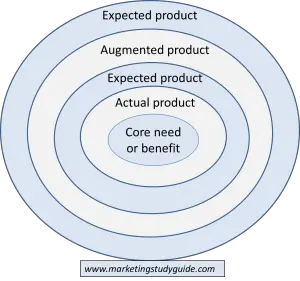Most marketing textbooks will show the products as having three distinct levels, namely the core benefit or need, the actual product itself, and the augmented product.
Please note that there is a separate article on this website that discusses the three product level model.
However, in some more advanced marketing textbooks, this model is expanded to include five different product levels, as follows:
- Core need (main consumer benefit)
- Actual (or basic) product (design and features)
- Expected product
- Augmented product
- Potential product
Key differences between the three and five product level models
This five product level model is based on Levitt’s 1980 article, which explored the art of differentiation.
As another page on this website already discusses the core need, the actual product and the augmented product, this article will concentrate upon the two additional levels of the expected product and the potential product.
Let’s start by looking at the diagram of five product levels model. You will note that the core need remains the same as the center piece of the product offering. This is surrounded by the actual or basic product level, which is consistent with the three product level model.
However, this is followed by the expected product – which is new to this model – and then finally the potential product is listed on the outside, which is also a new to the five level product model.
Expected product
When consumers buy a product, they essentially are buying a solution to a problem that they are facing, or are seeking specific benefits (that is, the core need). Marketers help develop products that meet these needs in unique ways (that is, a differentiated in the marketplace) by designing and launching the actual/basic product.
When this happens, it is important to consider the basic expectations of this style of product from the consumer. There is a danger that the product design may be to focus on differentiation and fail to include the straightforward expectations of consumers. Therefore, the expected product becomes the checkpoint for a marketer to consider the completeness of the product offering.
Examples of the expected product
Let’s look at some simple examples. If we were buying a can of soft drink – that product might be differentiated by using the actual product level by a combination of flavor, ingredients, serving size, branding, and so on.
The expectations of the consumer would also include: that the soft drink would be easy to open, it would be safe to drink with various health conditions or medications, the drink is easy to carry, and so on.
If we visit a fast food restaurant, then the expectations would include: friendly and fast customer service, restroom facilities, clean tables, security and a feeling of being safe, and so on.
If we buy a computer, then the expected product would include: a warranty on the computer, all hardware included (such as chargers), a phone number to call if there is a problem, online support, and so on.
Obviously, part of these product attributes will normally fall into the actual product level, or the augmented product level. But they are separated into their own level as part of this model, in order to ensure that they are not accidentally overlooked by the marketer, when trying to design a differentiated and competitive product in the marketplace.
Potential product
This is the final level in the five product level model. And it is really considering how the product can be modified into the future, primarily to generate future sales from existing customers. We can do this through product improvements and enhancements over time, which will provide some form of additional benefits to the consumer.
In many cases, the potential product will form part of the firm’s customer relationship management programs. Typically they should be planned programs, as part of the overall product development process.
Examples of the potential product
Again, probably the easiest way to understand the potential product is through some examples.
The computer software industry is in good example start with. Most consumers have Microsoft products on their computer, such as Word and Excel. Every couple of years, these products are upgraded to a new version with new capabilities. The prime target markets of these upgraded pieces of software are existing customers.
While this provides a good income stream for Microsoft, it also provides a reassurance benefit for consumers. When they buy a Microsoft product, they have the confidence that the product will be supported and they will be able to update the new software and technology, as required.
Another example might be joining a fitness center with a five-year membership contract. The consumer might be enticed into a five-year contract, because the fitness center has plans to add new facilities and services over time. Therefore, the consumer is attracted not only by the existing product, but also by the potential product.
RELATED TOPICS
External references
Levitt’s original 1980 paper on the additional levels (Harvard Business Review)

